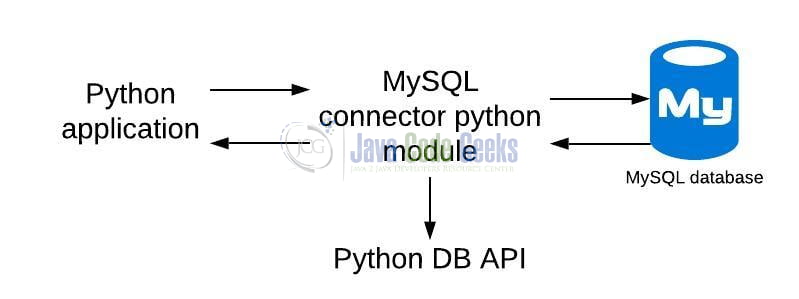Python MySQL Connection
Hello in this tutorial, we will understand how to connect to the MySQL server via python programming.
1. Introduction
To connect with MySQL in python programming we have the following modules that are commonly available and known to the developer world as all these modules adhere to the python database api specification –
- MySQL Connector Python – It is a preferred choice in the developer’s community as it is capable of executing database queries through python. It is python3 compatible and actively maintained
- pyMySQL
- MySQLDB
- MySqlClient
1.1 Setting up Python
If someone needs to go through the Python installation on Windows, please watch this link. You can download the Python from this link.
1.2 Setting up MySQL Connector Python
Once the python is successfully installed on your system you can install the MySQL Connector Python using a simple pip command. You can fire the below command from the command prompt and it will successfully download the module from pypi.org and install it.
Installation command
pip install mysql-connector-python
1.3 Setting up MySQL server container
To start with the tutorial, I am hoping that you have the MySQL up and running in your localhost environment. For easy setup, I have the server up and running on the docker environment. You can execute the below command to get the container running on docker in minutes.
Docker commands
docker run --name mysql -e MYSQL_ROOT_PASSWORD=password123 -e MYSQL_DATABASE=user -p 3306:3306 -d mysql
If everything goes well the container would be started successfully as shown in Fig. 1. You can use the docker ps -a command to confirm that the container is started successfully. For further information on docker basics, you can navigate to this tutorial.
2. Python MySQL Connection
Before going any deeper in the practical let me walk you through a simple architecture diagram where it shows that wherein the mysql connector python module fits in the picture.
For the MySQL connector python module to work we will supply the following attributes to the mysql from the python application i.e.
- user – Identity user to work with the mysql database. Default mysql user is
root - password – Credential of the identity user
- host – Address of the database server. If running on localhost then you can either use localhost or 127.0.0.1
- port – The port number. Default mysql port is
3306 - database – Database to which you want to connect. It can be left blank
3. Code Example
Let us dive in with the programming stuff now.
3.1 Create a configuration file
Add the following code to the environment file wherein we will specify the connection and database details. You are free to change these details as per your configuration setup.
local.env
[DB] username = root password = password123 host = localhost port = 3306 database = user
3.2 Reading the configuration
Add the following code to the python script which will read the configuration file created above and return the config object to be used later while connecting to the MySQL server. The script will import the configparser module for reading the configuration file. Remember to give the correct path where the local.env is created.
readdbconfig.py
import configparser
def read_db_params():
# reading the env file
config = configparser.ConfigParser()
config.read('config/local.env')
return config
3.3 Connecting to the database
Add the following code to the python script which will connect to the MySQL server with the help of the mysql.connector module.
connecttomysqldb.py
# python mysql
import mysql.connector
from mysql.connector import Error
from readdbconfig import *
def connect():
try:
# method will read the env file and return the config object
params = read_db_params()
# connect to database
# reading the database parameters from the config object
conn = mysql.connector.connect(
host=params.get('DB', 'host'),
database=params.get('DB', 'database'),
user=params.get('DB', 'username'),
password=params.get('DB', 'password'),
port=params.get('DB', 'port')
)
return conn
except(Exception, Error) as error:
print(error)
3.4 Printing MySQL server version
Add the following code to the python script which will connect to the MySQL server with the help of the mysql.connector module and print the MySQL version.
printmysqldbversion.py
# python mysql
from connecttomysqldb import *
def print_version(conn):
# creating a cursor to perform database operations
cursor = conn.cursor()
try:
# execute the sql query
cursor.execute('SELECT version();')
# fetch result
record = cursor.fetchone()
print('MySQL version = {}'.format(record))
except(Exception, Error) as error:
print(error)
finally:
if conn is not None:
cursor.close()
conn.close()
print('\nConnection closed')
# driver code
if __name__ == '__main__':
# ops method
print_version(connect())
4. Demo logs
The printmysqldbversion.py script will connect to the MySQL server to fetch the version details and show it on the IDE console. If not the exception message will be shown.
Demo logs
MySQL version = ('8.0.23',)
Connection closed
That is all for this tutorial and I hope the article served you with whatever you were looking for. Happy Learning and do not forget to share!
5. Summary
In this tutorial, we learned:
- Introduction to MySQL connector python module
- Sample program to connect to the MySQL server and print its version
You can download the source code of this tutorial from the Downloads section.
6. Download the Project
This was a python programming tutorial to connect to the MySQL server with the help of the MySQL connector python module.
You can download the full source code of this example here: Python MySQL Connection




